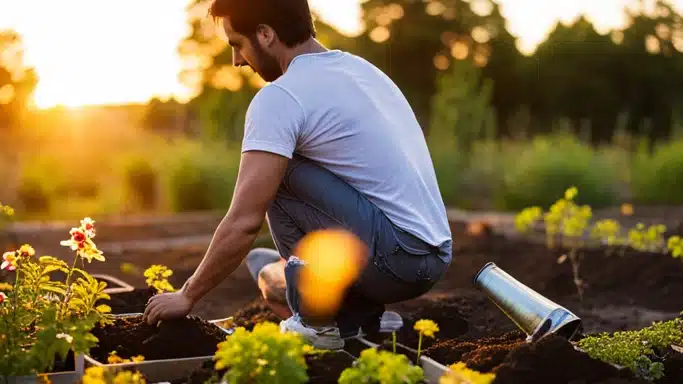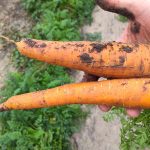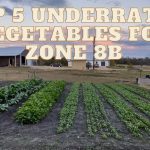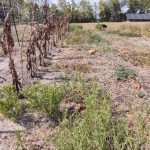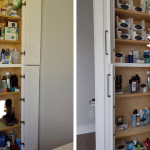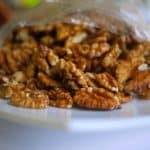Are you looking to add some fresh, yummy veggies to your diet? Well, planting a spring veggie garden in Zone 8b is the perfect solution! With its warm and humid climate, Zone 8b is a great place to grow tasty veggies. Why settle for the grocery store when you can grow it in your own garden? Not only are you able to choose what variety of veggies to grow, but the taste is superior to anything you can buy at the store. The crunchy taste of a freshly picked cucumber is delicious and refreshing.
So, in this post, we’ll focus on what you need to know about our zone 8b climate, the top ten veggies you can grow, along with a few other tips and tricks we’ve learned along the way to help you get started. So let’s dig in!
What to know about the climate in zone 8b
If you’re in Zone 8b, you probably already know that it falls under the USDA Plant Hardiness Zone Map. This is a go-to resource for many of us to figure out what plants will thrive in our area. As a Zone 8b gardener, you can expect long growing seasons, mild winters with really hot summers. Just keep in mind that the peak heat of the summer can act like a “winter” in the sense that not many plants can be grown during this time. Because of this, summer in zone 8b is usually a gardener’s dormant season where only a few plants can thrive. Plus, who wants to work out in the heat of 100-degree weather?
What vegetables should I plant in zone 8b?
When it comes to being successful in your Zone 8b vegetable garden the key is choosing the right types of vegetables and varieties. In spring, the soil is just starting to warm up and the days are getting longer, making it the perfect time to plant your garden. There is no exact science, but your success rate will increase if you research your varieties and get your timing right. Below is a chart with our top ten options for planting vegetables in zone 8b. While you will have success with most of them there is a varying degree of difficulty with some of them either due to timing or pest pressure but it can be done. The chart below lists the top ten vegetables along with a difficulty rating, how they need to be planted, a time range, as well as additional notes we’ve found helpful in our own garden.
Let’s talk about the best veggies for Zone 8b for spring
| Name | Type | Time to start seeds indoors in zone 8b | Time to plant in ground zone 8b | Difficulty | Notes |
|---|---|---|---|---|---|
| Tomatoes | From seed | Mid-January to Mid-February | Medium/Hard – depending on the variety | Need additional equipment lights, containers, etc. | |
| Tomatoes (Plant) | Transplant | Mid-February – Mid/Late March | Medium/Hard – depending on the variety | You can purchase at local nurseries | |
| Cucumbers | From seed | Early/Late March | Easy | Need additional equipment lights, containers, etc. | |
| Cucumbers | Transplant (Plant) | Mid-March – Mid-April | Easy | ||
| Peppers | From seed | Early/Mid-January | Medium | Need additional equipment lights, containers, etc. | |
| Peppers | Transplant (Plant) | Mid/Late March | Medium | Wider range for planting but listed are optimal times. | |
| Potatoes | Seed potatoes | Easy | |||
| Sweet Potatoes | Slips | March-April | May-August | Easy | |
| Summer Squash | Direct seed | Mid-March – Early April | Easy | ||
| Bok Choy | Direct seed | Late Feb – Early March | Medium | Tend to get pest pressure | |
| Green Beans | Direct seed | March – April | Easy | ||
| Corn | Direct seed | Mid-March – April | Hard | ||
| Mizuna Greens | Direct seed | Late Feb – March | Easy |
Additional mentions:
Don’t forget about melons! Although they’re not technically a vegetable, they have a similar growth pattern to cucumbers and are a great option for planting in the spring. They are easy to grow and can be direct-seeded or transplanted.
| Name | Type | Time to start seeds indoors in zone 8b | Time to plant in ground zone 8b | Difficulty | Notes |
|---|---|---|---|---|---|
| Melons | Direct seed | Mid-Late March | Easy | Cheaper to just direct seed | |
| Melons | Transplant (Plant) | Mid-Late March | Easy |
With these delicious and nutritious options, you’ll have a thriving vegetable garden in no time!
The importance of optimal timing when planting vegetables in Zone 8b.
The timing of planting in your vegetable garden can make or break your crops. Plant too early and a late frost could damage or kill your delicate seedlings, while planting too late may not give your veggies enough time to mature before the summer heat sets in and zaps them.
Here’s how you can get the timing right:
- If you are planting one of the ten vegetables above, you can just look at my handy dandy chart and see when you need to pop it in the ground.
- Look up to see the average for your last frost date in your local area. But note that some years you may get a surprise frost. Sometimes, it is a guessing game but most of the time that will give you a good idea.
- Know the maturity time for the veggies you plan to grow. This will give you an idea of how long it will take the plant to mature and help you with your timing.
- Soil temperature for each vegetable. This is helpful if you are direct seeding. Each plant requires a minimum soil temp to start germinating. Some seeds will germinate better with cooler soil temperatures some need to have a warmer soil temperature. Most of the time it’s not a huge factor but keep it in mind especially when we have colder-than-usual winters.
Other factors to consider
Alright, let’s talk about some other tips and tricks to help you when planting your vegetable garden in Zone 8b.
8b Garden Plan
A garden plan is a must-have for any vegetable garden. It helps you figure out what you want to grow, where you want to grow it, and how you want to arrange your plants. Having a garden plan ensures that you make the most of the space in your garden, avoid overcrowding, and provide your plants with the right sun exposure and water. Also as you are planning your garden keep in mind the mature size of each plant, and consider the position of your garden in relation to the sun.
Check out our garden plan below and see how we decided to lay out our garden. Just to note our first year we actually planted it in the east-to-west direction. But based on the variety of veggies we plan to grow this season we decided it would be more beneficial to switch to a north-to-south orientation. Sometimes you just have to spice things up.
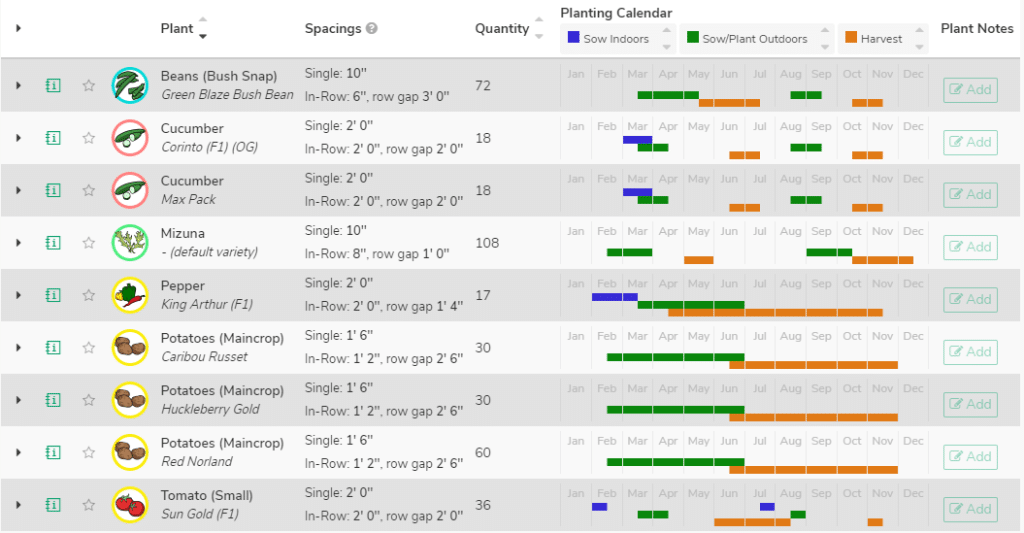
Plant Spacing
Plant spacing is crucial in a vegetable garden. Different plants have varying growth habits, so it’s essential to research each plant you want to grow and arrange your spacing accordingly. Believe me, this can really help in maintaining your garden when the plants mature, and giving plants enough space also helps keep them healthy keeping diseases and pests at bay. Correct spacing will also give each plant enough room to grow and receive the right amount of sun exposure and water.
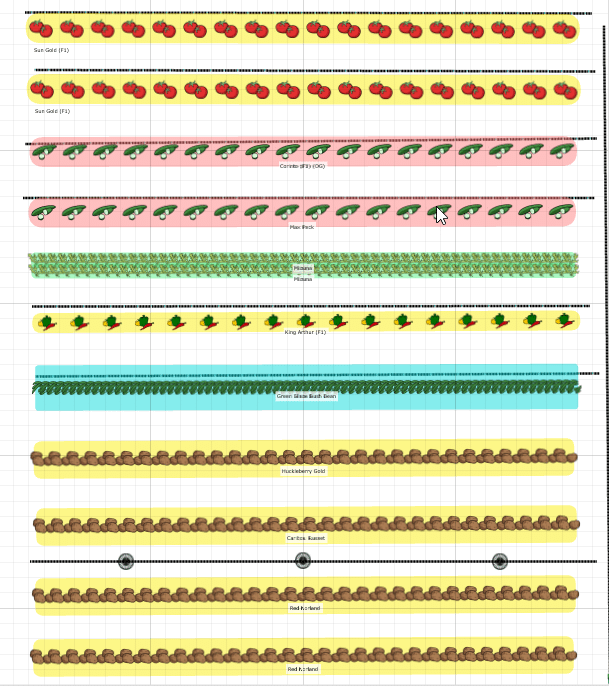
Direct Seeding vs. Transplants
There are two ways to plant in a vegetable garden – direct seeding or using transplants. Direct seeding involves planting seeds directly in the garden, while transplants are seedlings that have been started indoors or in a greenhouse. Transplants are a good choice for certain vegetables, like tomatoes or peppers, as they can be started early and planted in the garden once the soil has warmed up. Direct seeding is a more cost-effective option and works well for crops that can be easily grown from seed. We’ll go into more detail about this topic in another blog. But for now, refer to the chart above to see if you should direct seed or transplant.
Soil Preparation
Soil preparation can play an important role in the success of your vegetable garden. Make sure your soil is well-drained, fertile, and has the correct pH balance. Ideally, everyone wishes they had the perfect soil but honestly, this is always a work in progress and an ongoing project. You will be amending your soil in one way or another after each season. So if your soil is not the greatest don’t fret. There are ways to build it up. It takes time and patience and some additional planning.
Irrigation
Zone 8b gets a good amount of rain each year, but you still need to find a way to water your plants. Depending on the size of your garden there is a variety of options to choose from. If you are gardening in containers or have a small garden you can opt to just hand water. If you want to have a more automated option you can hook up something like drip irrigation. Another popular option is to add overhead sprinklers, however not all plants like having wet leaves so before going that route I would make sure you have a solid plan on which plants you are planting on planting. Or you could set it up so that it can be put up and taken down.
Zone 8b gets a good amount of rain, but that doesn’t mean your plants are all set. You will still need to make sure they get enough water. Now, the size of your garden is going to play a big part in how you water it. If you have a small garden or some planters, you can just grab a hose or watering can and water your plants. But if you want something that’s more automatic, you could try installing a drip irrigation system. There are a lot of configurations you can set up along with overhead sprinklers. If you choose to go with the overhead sprinkler system just remember not all plants like getting their leaves wet. So, before you go that route, make sure you know which plants can handle it. Or, you could always set up a system that’s easy to take apart and put back together.
Garden Pests and Diseases in zone 8b
Each region will have its own common garden pests and diseases that can cause damage to your plants and reduce your harvest. By knowing some of the most common pests and diseases in your local area, you can take preventive measures to help or treat any problems that may come up. Some of the most frequent pests and diseases in Zone 8b include aphids, caterpillars, cutworms, whiteflies, tomato hornworms, powdery mildew, and specific vegetable issues such as blossom end rot and verticillium wilt in tomatoes.
Preventive Measures:
Here are a few tips to prevent or treat pests and diseases in your vegetable garden:
- Maintaining Garden Cleanliness: Keeping your garden neat and free of debris can help reduce the occurrence of pests and diseases. This includes spacing and making sure each plant is able to get enough air to help keep it healthy.
- Crop Rotation: Alternating your crops from year to year can minimize the buildup of pests and diseases in the soil.
- Natural Pest Control: Encouraging beneficial insects such as ladybugs and lacewings can help control pests in your garden. Planting plants and or flowers to attract pollinators is also a good idea and can help with this.
- Early Detection: Honesty, this is a big one. Regularly inspecting your plants for signs of pests or diseases can help you catch and treat issues early. So get outside, get some sunshine, and enjoy a walk in your garden.
- Treatment Options: There are both natural and chemical treatment options available for pests and diseases. Going organic is preferable after all you will be eating these veggies. So sometimes the best thing to do is look at the pros and cons of each. Either way, make sure to follow the instructions carefully. We like to use organic sprays like spinosad and neem oil. Get a regular spraying rotation going – for example we will spray every week if there is high pest pressure. Be sure to spray at the end of the day to minimize harm to the beneficial insects and pollinators in your area.
Give it a go in zone 8b!
Ultimately, you can read about gardening all day long but the truth is you just need to get out there and plant something. You will have successes and failures but at the end of the day, you just need to dig in and give it a go. Happy planting 🙂


